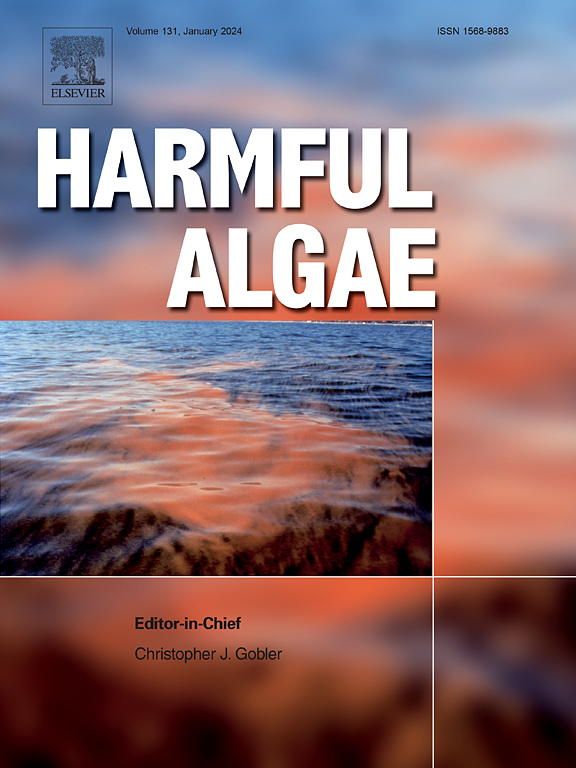温度和盐度对河口环境中铜绿微囊藻(pcc7806)生长和毒素含量的影响
IF 4.5
1区 生物学
Q1 MARINE & FRESHWATER BIOLOGY
引用次数: 0
摘要
铜绿微囊藻被认为是一种有害的蓝藻物种,因为它能够产生微囊藻毒素(MCs),并且在河口环境中越来越普遍。虽然以前的研究已经证明了个别环境因素对铜绿假单胞菌生长或毒素含量的影响,但其潜在的相互作用及其毒性的变化仍不清楚。在这项研究中,我们首先进行了一个正交设计的生长实验,以评估温度、盐度、pH值和营养条件变化的潜在影响。随后,我们进行了以温度和盐度为关键变量的全因子生长实验。在指数生长和平稳生长阶段分别测定细胞内和细胞外MCs含量以及藻蓝蛋白水平。根据底栖桡足动物Nitokra spinipes和浮游桡足动物Acartia tonsa的死亡率和游泳行为进一步评估毒性。结果表明,随着温度的升高(15 ~ 28℃),生长速率和MCs含量显著增加,但随着盐度的升高(8 ~ 16 ppt),生长速率和MCs含量均下降。此外,细胞密度与细胞内和细胞外MCs含量均显著相关。温度和盐度之间存在显著的相互作用。胞内MCs与藻蓝蛋白含量无相关性。最后,与无毒的盐红单胞菌相比,暴露于铜绿假单胞菌导致tonsa的游泳速度降低,不活动增加,死亡率更高。我们的研究强调了温度和盐度对铜绿假单胞菌生长和毒素产生的影响,为未来爆发的潜在生态毒理学风险提供了更多的见解。本文章由计算机程序翻译,如有差异,请以英文原文为准。
Temperature and salinity affect growth and toxin content of cyanobacterium Microcystis aeruginosa (PCC 7806) in estuarine environments
Microcystis aeruginosa is considered a harmful cyanobacterial species due to its ability to produce microcystins (MCs) and its increasing prevalence in estuarine environments. While previous studies have demonstrated the effects of individual environmental factors on either growth or toxin content of M. aeruginosa, potential interactive effects and resulting changes in its toxicity remain unclear. In this study, we first conducted an orthogonally designed growth experiment to assess potential effects of changes in temperature, salinity, pH, and nutrient conditions. Subsequently, we performed a full-factorial growth experiment focusing on temperature and salinity as key variables. Intracellular and extracellular MCs content, as well as phycocyanin levels, were measured during both exponential and stationary growth phases. Toxicity was further evaluated based on mortality and swimming behavior of the epibenthic copepod Nitokra spinipes and the planktonic copepod Acartia tonsa. Results showed that both growth rate and MCs content significantly increased with temperature (from 15 to 28 °C) but decreased with higher salinity (from 8 to 16 ppt). Moreover, cell density was significantly correlated with both intracellular and extracellular MCs contents. A significant interaction between temperature and salinity was observed. No correlation was found between intracellular MCs and phycocyanin contents. Finally, exposure to M. aeruginosa resulted in decreased swimming speed, increased inactivity, and higher mortality in A. tonsa, compared to the non-toxic Rhodomonas salina. Our study highlights the consequences of temperature and salinity on M. aeruginosa growth and toxin production, offering increased insights into the potential ecotoxicological risks of future blooms.
求助全文
通过发布文献求助,成功后即可免费获取论文全文。
去求助
来源期刊

Harmful Algae
生物-海洋与淡水生物学
CiteScore
12.50
自引率
15.20%
发文量
122
审稿时长
7.5 months
期刊介绍:
This journal provides a forum to promote knowledge of harmful microalgae and macroalgae, including cyanobacteria, as well as monitoring, management and control of these organisms.
 求助内容:
求助内容: 应助结果提醒方式:
应助结果提醒方式:


